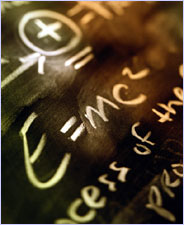
|
 |
 |
by Clifford Pickover What is time? Is time travel possible? For centuries, these questions have intrigued mystics, philosophers, and scientists. Much of ancient Greek philosophy was concerned with understanding the concept of eternity, and the subject of time is central to all the world's religions and cultures. Can the flow of time be stopped? Certainly some mystics thought so. Angelus Silesius, a sixth-century philosopher and poet, thought the flow of time could be suspended by mental powers: Time is of your own making;The line between science and mysticism sometimes grows thin. Today physicists would agree that time is one of the strangest properties of our universe. In fact, there is a story circulating among scientists of an immigrant to America who has lost his watch. He walks up to a man on a New York street and asks, "Please, Sir, what is time?" The scientist replies, "I'm sorry, you'll have to ask a philosopher. I'm just a physicist." Most cultures have a grammar with past and future tenses, and also demarcations like seconds and minutes, and yesterday and tomorrow. Yet we cannot say exactly what time is. Although the study of time became scientific during the time of Galileo and Newton, a comprehensive explanation was given only in this century by Einstein, who declared, in effect, time is simply what a clock reads. The clock can be the rotation of a planet, sand falling in an hourglass, a heartbeat, or vibrations of a cesium atom. A typical grandfather clock follows the simple Newtonian law that states that the velocity of a body not subject to external forces remains constant. This means that clock hands travel equal distances in equal times. While this kind of clock is useful for everyday life, modern science finds that time can be warped in various ways, like clay in the hands of a cosmic sculptor.
One of the earliest methods for fictional time travel didn't involve a machine; the main character in Washington Irving's "Rip van Winkle" (1819) simply fell asleep for decades. King Arthur's daughter Gweneth slept for 500 years under Merlin's spell. Ancient legends of time distortion are, in fact, quite common. One of the most poetic descriptions of time travel occurs in a popular medieval legend describing a monk entranced for a minute by the song of a magical bird. When the bird stops singing, the monk discovers that several hundred years have passed. Another example is the Moslem legend of Muhammad carried by a mare into heaven. After a long visit, the prophet returns to Earth just in time to catch a jar of water the horse had kicked over before starting its ascent. Time travel is possible Today, we know that time travel need not be confined to myths, science fiction, Hollywood movies, or even speculation by theoretical physicists. Time travel is possible. For example, an object traveling at high speeds ages more slowly than a stationary object. This means that if you were to travel into outer space and return, moving close to light speed, you could travel thousands of years into the Earth's future. Newton's most important contribution to science was his mathematical definition of how motion changes with time. He showed that the force causing apples to fall is the same force that drives planetary motions and produces tides. However, Newton was puzzled by the fact that gravity seemed to operate instantaneously at a distance. He admitted he could only describe it without understanding how it worked. Not until Einstein's general theory of relativity was gravity changed from a "force" to the movement of matter along the shortest space in a curved spacetime. The Sun bends spacetime, and spacetime tells planets how to move. For Newton, both space and time were absolute. Space was a fixed, infinite, unmoving metric against which absolute motions could be measured. Newton also believed the universe was pervaded by a single absolute time that could be symbolized by an imaginary clock off somewhere in space. Einstein changed all this with his relativity theories, and once wrote, "Newton, forgive me."
We are a moment in astronomic time, a transient guest of the Earth. Our wet, wrinkled brains do not allow us to comprehend many mysteries of time and space. Our brains evolved to make us run from saber-toothed cats on the American savanna, to hunt deer, and to efficiently scavenge from the kills of large carnivores. Despite our mental limitations, we have come remarkably far. We have managed to pull back the cosmic curtains a crack to let in the light. Questions raised by physicists, from Newton to Kurt Gödel to Einstein to Stephen Hawking, are among the most profound we can ask. Is time real? Does it flow in one direction only? Does it have a beginning or an end? What is eternity? None of these questions can be answered to scientists' satisfaction. Yet the mere asking of these questions stretches our minds, and the continual search for answers provides useful insights along the way. Continue: The future of time travel Sagan on Time Travel | Traveling Through Time Timespeak | Think Like Einstein | Resources Teacher's Guide | Transcript | Site Map Editor's Picks | Previous Sites | Join Us/E-mail | TV/Web Schedule About NOVA | Teachers | Site Map | Shop | Jobs | Search | To print PBS Online | NOVA Online | WGBH © | Updated November 2000 |
 What is time? The question is as hard to answer as
whether or not time travel will ever be possible.
What is time? The question is as hard to answer as
whether or not time travel will ever be possible.
 The first science-fiction story about time travel
appeared in the 1880s.
The first science-fiction story about time travel
appeared in the 1880s.
 Albert Einstein, whose theories of relativity changed
our understanding of time and space, once wrote
"Newton, forgive me."
Albert Einstein, whose theories of relativity changed
our understanding of time and space, once wrote
"Newton, forgive me."